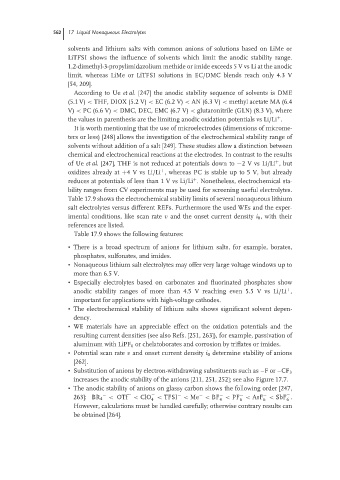Page 588 - Handbook of Battery Materials
P. 588
562 17 Liquid Nonaqueous Electrolytes
solvents and lithium salts with common anions of solutions based on LiMe or
LiTFSI shows the influence of solvents which limit the anodic stability range.
1,2-dimethyl-3-propylimidazolium methide or imide exceeds 5 V vs Li at the anodic
limit, whereas LiMe or LiTFSI solutions in EC/DMC blends reach only 4.3 V
[54, 209].
According to Ue et al. [247] the anodic stability sequence of solvents is DME
(5.1 V) < THF, DIOX (5.2 V) < EC (6.2 V) < AN (6.3 V) < methyl acetate MA (6.4
V) < PC (6.6 V) < DMC, DEC, EMC (6.7 V) < glutaronitrile (GLN) (8.3 V), where
the values in parenthesis are the limiting anodic oxidation potentials vs Li/Li .
+
It is worth mentioning that the use of microelectrodes (dimensions of microme-
ters or less) [248] allows the investigation of the electrochemical stability range of
solvents without addition of a salt [249]. These studies allow a distinction between
chemical and electrochemical reactions at the electrodes. In contrast to the results
+
of Ue et al. [247], THF is not reduced at potentials down to −2VvsLi/Li ,but
+
oxidizes already at +4Vvs Li/Li , whereas PC is stable up to 5 V, but already
+
reduces at potentials of less than 1 V vs Li/Li . Nonetheless, electrochemical sta-
bility ranges from CV experiments may be used for screening useful electrolytes.
Table 17.9 shows the electrochemical stability limits of several nonaqueous lithium
salt electrolytes versus different REFs. Furthermore the used WEs and the exper-
imental conditions, like scan rate v and the onset current density i 0 , with their
references are listed.
Table 17.9 shows the following features:
• There is a broad spectrum of anions for lithium salts, for example, borates,
phosphates, sulfonates, and imides.
• Nonaqueous lithium salt electrolytes may offer very large voltage windows up to
more than 6.5 V.
• Especially electrolytes based on carbonates and fluorinated phosphates show
+
anodic stability ranges of more than 4.5 V reaching even 5.5 V vs Li/Li ,
important for applications with high-voltage cathodes.
• The electrochemical stability of lithium salts shows significant solvent depen-
dency.
• WE materials have an appreciable effect on the oxidation potentials and the
resulting current densities (see also Refs. [251, 263]), for example, passivation of
aluminum with LiPF 6 or chelatoborates and corrosion by triflates or imides.
• Potential scan rate v and onset current density i 0 determine stability of anions
[262].
• Substitution of anions by electron-withdrawing substituents such as –F or –CF 3
increases the anodic stability of the anions [211, 251, 252]; see also Figure 17.7.
• The anodic stability of anions on glassy carbon shows the following order [247,
−
263]: BR 4 < OTf < ClO < TFSI < Me < BF < PF < AsF < SbF .
−
−
−
−
−
−
−
−
4 4 6 6 6
However, calculations must be handled carefully; otherwise contrary results can
be obtained [264].

